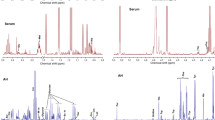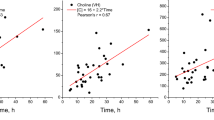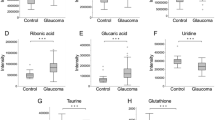Abstract
Introduction
Cornea is the outermost part of the eye supplied mostly by aqueous humor (AH). Therefore, the comparison of the metabolomic compositions of AH and cornea may help to determine which compounds are produced inside the cornea, and which penetrate into cornea from AH for intra-corneal consumption. Keratoconus (KC) is the most common form of the cornea dystrophy, and the analysis of KC corneas can unravel the metabolomic changes occurring in AH and cornea of KC patients.
Objectives
The work is aimed at the determination of concentrations of a wide range of metabolites in the human cornea and AH, the comparison of the metabolomic profiles of cornea and AH, and the comparison of the metabolomic compositions of samples taken from KC patients and normal donors (post-mortem).
Methods
The quantitative metabolomic profiling was carried out with the use of two independent methods—high-frequency 1H NMR spectroscopy and HPLC with high-resolution ESI-MS detection.
Results
The concentrations of 71 most abundant metabolites in cornea and AH from keratoconus patients and from human cadavers have been measured. It is found that the concentrations of purines and organic acids in cornea are significantly higher than in AH. The KC corneas are characterized by the enhanced levels of acetate and citrate, and also by low values of GSH/GSSG ratios.
Conclusion
A significant difference in the metabolomic compositions of the human AH and cornea has been revealed. The concentrations of glucose and some amino acids in cornea are significantly lower than in AH, indicating their fast consumption inside the cornea. The high levels of organic acids, purines and GSH in cornea should be attributed to their production in the cornea. The enhanced levels of acetate and citrate as well as the low values of GSH/GSSG ratios in KC corneas are the indicators of the oxidative stress.



Similar content being viewed by others
References
Ambekar, R., Toussaint, K. C. Jr., & Wagoner Johnson, A. (2011). The effect of keratoconus on the structural, mechanical, and optical properties of the cornea. Journal of the Mechanical Behavior of Biomedical Materials, 4(3), 223–236.
Arnal, E., Peris-Martínez, C., Menezo, J. L., Johnsen-Soriano, S., & Romero, F. J. (2011). Oxidative stress in keratoconus? Investigative Ophthalmology & Visual Science, 52(12), 8592–8597.
Buddi, R., Lin, B., Atilano, S. R., Zorapapel, N. C., Kenney, M. C., & Brown, D. J. (2002). Evidence of oxidative stress in human corneal diseases. The Journal of Histochemistry & Cytochemistry, 50(3), 341–351.
Chaerkady, R., Shao, H., Scott, S.-G., Pandey, A., Jun, A. S., & Chakravarti, S. (2013). The keratoconus corneal proteome: Loss of epithelial integrity and stromal degeneration. Journal of Proteomics, 87, 122–131.
Cotran, R. S., Kumar, V., & Robbins, S. L. (1994). Cellular injury and cellular death (5th edn.). Philadelphia: W.B. Saunders Company.
Delamere, N. A. (1996). Ascorbic acid and the eye. Subcellular Biochemistry, 25, 313–329.
DiMattio, J. (1989). A comparative study of ascorbic acid entry into aqueous and vitreous humors of the rat and guinea pig. Investigative Ophthalmology & Visual Science, 30(11), 2320–2331.
Donaldson, A. E., & Lamont, I. L. (2013). Biochemistry changes that occur after death: Potential markers for determining post-mortem interval. PLoS ONE, 8(11), e82011.
Donaldson, A. E., & Lamont, I. L. (2014). Estimation of post-mortem interval using biochemical markers. Australian Journal of Forensic Sciences, 46(1), 8–26.
Donaldson, A. E., & Lamont, I. L. (2015). Metabolomics of post-mortem blood: Identifying potential markers of post-mortem interval. Metabolomics, 11(1), 237–245.
Dunn, W. B., Broadhurst, D. I., Atherton, H. J., Goodacre, R., & Griffin, J. L. (2011). Systems level studies of mammalian metabolomes: The roles of mass spectrometry and nuclear magnetic resonance spectroscopy. Chemical Society Reviews, 40, 387–426.
Gowda, G. A. N., Gowda, Y. N., & Raftery, D. (2015). Expanding the limits of human blood metabolite quantitation using NMR spectroscopy. Analytical Chemistry, 87(1), 706–715.
Gowda, G. A. N., & Raftery, D. (2014). Quantitating metabolites in protein precipitated serum using NMR spectroscopy. Analytical Chemistry, 86(11), 5433–5440.
Gowda, G. A. N., Zhang, S., Gu, H., Asiago, V., Shanaiah, N., & Raftery, D. (2008). Metabolomics-based methods for early disease diagnostics. Expert Review of Molecular Diagnostics, 8(5), 617–633.
Joseph, R., Srivastava, O. P., & Pfister, R. R. (2011). Differential epithelial and stromal protein profiles in keratoconus and normal human corneas. Experimental Eye Research, 92(4), 282–298.
Karamichos, D., Hutcheon, A. E., Rich, C. B., Trinkaus-Randall, V., Asara, J. M., & Zieske, J. D. (2014). In vitro model suggests oxidative stress involved in keratoconus disease. Scientific Reports, 4, 4608.
Karamichos, D., Zieske, J. D., Sejersen, H., Sarker-Nag, A., Asara, J. M., & Hjortdal, J. (2015). Tear metabolite changes in keratoconus. Experimental Eye Research, 132, 1–8.
Keleş, M. S., Keleş, S., Kulaçoğlu, D. N., Taysí, S., Baykal, O., Memíşoğullari, R., et al. (2011). Free amino acid concentration in aqueous humour of patients with nuclear or cortical cataract. Turkish Journal of Medical Sciences, 41(3), 501–505.
Kryczka, T., Ehlers, N., Nielsen, K., Wylęgała, E., Dobrowolski, D., & Midelfart, A. (2013a). Metabolic profile of keratoconic cornea. Current Eye Research, 38(2), 305–309.
Kryczka, T., Szaflik, J. P., Szaflik, J., & Midelfart, A. (2013b). Influence of donor age, post-mortem time and cold storage on metabolic profile of human cornea. Acta Ophthalmologica, 91(1), 83–87.
Kryczka, T., Wylęgała E., Dobrowolski, D., & Midelfart, A. (2014). NMR spectroscopy of human eye tissues: A new insight into ocular biochemistry. The Scientific World Journal, 2014, 546192.
Mishur, R. J., & Rea, S. L. (2012). Applications of mass spectrometry to metabolomics and metabonomics: Detection of biomarkers of aging and of age-related diseases. Mass Spectrometry Reviews, 31(1), 70–95.
Morishige, N., Shin-gyou-uchi, R., Azumi, H., Ohta, H., Morita, Y., Yamada, N., et al. (2014). Quantitative analysis of collagen lamellae in the normal and keratoconic human cornea by second harmonic generation imaging microscopy. Investigative Ophthalmology & Visual Science, 55(12), 8377–8385.
Saijyothi, A. V., Fowjana, J., Madhumathi, S., Rajeshwari, M., Thennarasu, M., Prema, P., et al. (2012). Tear fluid small molecular antioxidants profiling shows lowered glutathione in keratoconus. Experimental Eye Research, 103, 41–46.
Shoham, A., Hadziahmetovic, M., Dunaief, J. L., Mydlarski, M. B., & Schipper, H. M. (2008). Oxidative stress in diseases of the human cornea. Free Radical Biology & Medicine, 45(8), 1047–1055.
Snytnikova, O. A., Khlichkina, A. A., Yanshole, L. V., Yanshole, V. V., Iskakov, I. A., Egorova, E. V.,et al (2017). Metabolomics of the human aqueous humor. Metabolomics, 13, 5.
Tamara, S. O., Yanshole, L. V., Yanshole, V. V., Fursova, A. Z., Stepakov, D. A., Novoselov, V. P., et al. (2016). Spatial distribution of metabolites in the human lens. Experimental Eye Research, 143, 68–74.
Tan, S. Z., Begley, P., Mullard, G., Hollywood, K. A., & Bishop, P. N. (2016). Introduction to metabolomics and its applications in ophthalmology. Eye (London, England), 30(6), 773–783.
Truscott, R. J. (2005). Age-related nuclear cataract-oxidation is the key. Experimental Eye Research, 80(5), 709–725.
Tsentalovich, Y. P., Verkhovod, T. D., Yanshole, V. V., Kiryutin, A. S., Yanshole, L. V., Fursova, A. Z., et al. (2015). Metabolomic composition of normal aged and cataractous human lenses. Experimental Eye Research, 134, 15–23.
Wojcik, K. A., Blasiak, J., Szaflik, J., & Szaflik, J. P. (2014). Role of biochemical factors in the pathogenesis of keratoconus. Acta Biochimica Polonica, 61(1), 55–62.
Wojcik, K. A., Kaminska, A., Blasiak, J., Szaflik, J., & Szaflik, J. P. (2013). Oxidative stress in the pathogenesis of keratoconus and Fuchs endothelial corneal dystrophy. International Journal of Molecular Sciences, 14(9), 19294–19308.
Yanshole, V. V., Snytnikova, O. A., Kiryutin, A. S., Yanshole, L. V., Sagdeev, R. Z., & Tsentalovich, Y. P. (2014). Metabolomics of the rat lens: A combined LC-MS and NMR study. Experimental Eye Research, 125, 71–78.
Zelentsova, E. A., Yanshole, L. V., Snytnikova, O. A., Yanshole, V. V., Tsentalovich, Y. P., & Sagdeev, R. Z. (2016). Post-mortem changes in the metabolomic compositions of rabbit blood, aqueous and vitreous humors. Metabolomics, 12(11), 172.
Zhang, A., Sun, H., Yan, G., Wang, P., & Wang, X. (2016). Mass spectrometry-based metabolomics: Applications to biomarker and metabolic pathway research. Biomedical Chromatography, 30(1), 7–12.
Acknowledgements
The work was supported by the SB RAS (Program “Integration and development” II.2П/V.44-18, project 0333-2016-0004) in NMR measurements, by RFBR (projects 17-03-00656) in LC-MS measurements, and by FASO Russia (project 0333-2016-0001) in sample preparation.
Author information
Authors and Affiliations
Corresponding author
Ethics declarations
Conflict of interest
Authors declare that there is no conflict of interest.
Informed consent
All participants signed an informed consent form.
Research involving human participants and/or animals
The study was conducted in accordance with the Declaration of Helsinki (2013) of the World Medical Association, and with the ethical approval from International Tomography Center.
Electronic supplementary material
Below is the link to the electronic supplementary material.
Rights and permissions
About this article
Cite this article
Snytnikova, O.A., Yanshole, L.V., Iskakov, I.A. et al. Quantitative metabolomic analysis of the human cornea and aqueous humor. Metabolomics 13, 152 (2017). https://doi.org/10.1007/s11306-017-1281-0
Received:
Accepted:
Published:
DOI: https://doi.org/10.1007/s11306-017-1281-0




